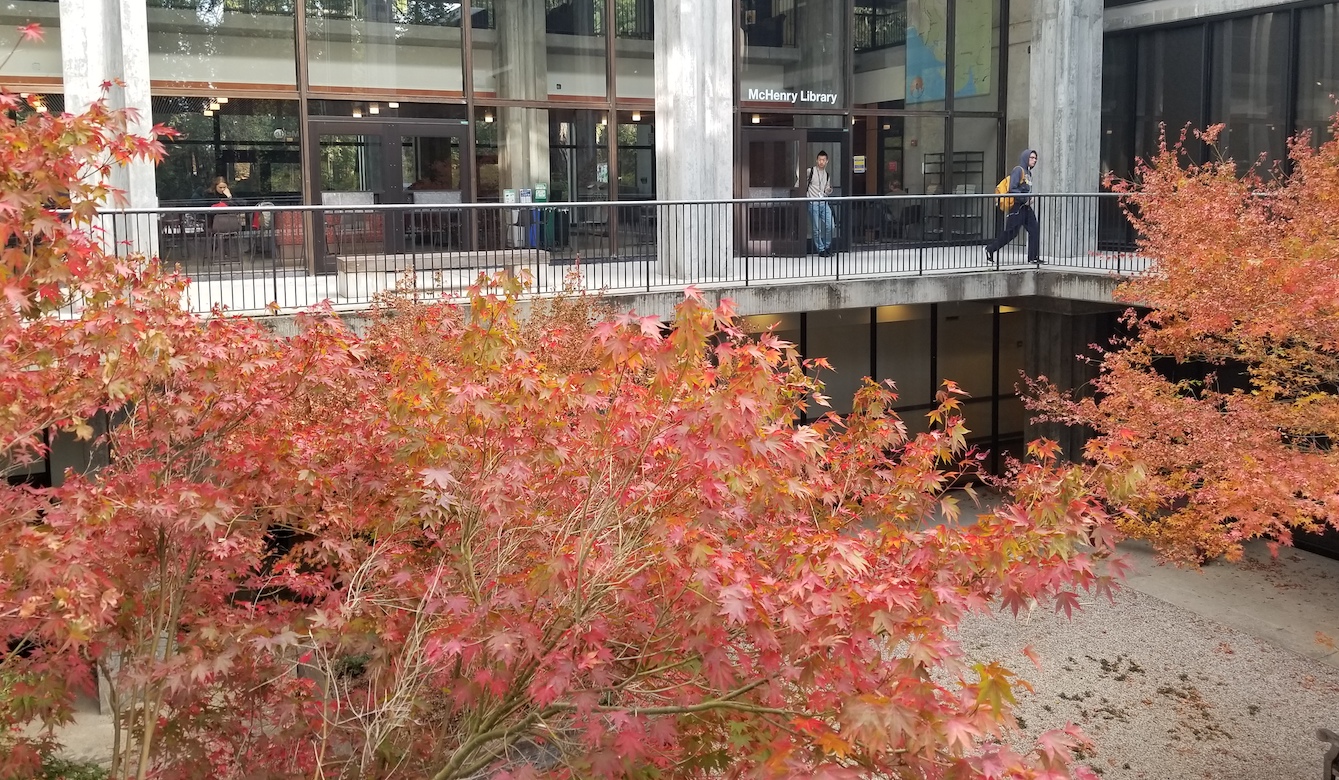
Beautiful autumn colors frame the Donald T. Clark Courtyard at McHenry Library
From the University Librarian
Communication and Collaboration - The new STEM Hub at S&E
Inclusive and Effective Classrooms Benefit Students
Our donor highlight features Professor Emerita Margaret Brose
Science & Engineering Library Renovation Update
News from Special Collections and Archives
- Songs of Labor & Transcendence: The Trianon Press Archive
- Put Your Gold Money Where Your Love Is, Baby: Counterculture, Capitalism, and the Grateful Dead
- Seeds of Something Different: Documenting UC Santa Cruz in Image and Narrative
- When We Paint Our Masterpiece: The Art of the Grateful Dead Community
Collectors' Club Selection Day
An Easy Way to Support the UC Santa Cruz Library
Dear Friends and Supporters,
Fall quarter is now in full swing, and the libraries at UCSC are full of students preparing for papers, quizzes, and exams. As we head into the holiday season, I thought it would be a good time to reflect on the culture of collaboration at the University Library at UC Santa Cruz.
University libraries are by nature collaborative, working across disciplines and formats and with all types of technology to aid in their patrons’ research. I truly believe everything is better when we collaborate across divisions.
To that end, both the McHenry and Science & Engineering libraries provide essential services by pulling in key partners, including the Hispanic-Serving Institution (HSI) Initiatives and the Division of Physical & Biological Sciences. Together, we have created spaces to better serve students and faculty in our core mission: Promoting the discovery of information and creation of knowledge and leading the University in disseminating and preserving scholarship for the benefit of humanity.
When more groups have experience with our services, it becomes easier to communicate and define what we do, making our library more vital on campus. We can get direct feedback about what is working for these groups—and, more importantly, what is not working. For example, the new STEM Hub at the Science & Engineering Library was established in partnership with UC Santa Cruz’s HSI Initiatives (represented by their Assistant Director, René Moreno, who is interviewed in this newsletter) to improve student success rates for STEM students from underrepresented communities.
When we reached out to STEM students and asked them about their experience as a member of the campus community, we discovered that many simply didn’t know where to find necessary services, academic support, and a place of community on campus. By hosting advising, tutoring, and student support services in the library—where students already gather—we aim to make it easier for them to find and make use of these vital student success resources.
Similarly, the Active Learning Classroom in the Science & Engineering Library (which was featured in a previous newsletter) is being used by faculty members such as Distinguished Professor Susan Strome in PBSci to explore best practices in teaching. These cutting-edge facilities allow our faculty to experiment with pedagogical best practices and implement them on a much larger scale. The open, collegial nature of this facility further helps to expand community and a sense of belonging to our students, which has been shown to increase retention rates across the board.
Our donor highlight this quarter features Professor Emerita Margaret Brose—who together with her late husband, Professor Emeritus Hayden White—donated over 140 rare books to the University Library Special Collections & Archives to form the Brose-White Rare Book Collection. White’s papers and annotated books are also part of Special Collections & Archives, and just this quarter have been the focus of both an on-going exhibit at McHenry Library as well as a two-day conference sponsored in White’s memory by the Humanities Institute. Brose and White are an excellent example of how UC Santa Cruz faculty stay connected and give back to our campus throughout their lives and careers, and how Special Collections & Archives reflects the truly interdisciplinary nature of our faculty.
With these innovations and others, the University Library is constantly examining what our users tell us about their evolving needs and responding creatively to meet them. A collaborative mindset is key to this approach as we recognize that now more than ever, the whole is greater than the sum of its parts here at UC Santa Cruz.
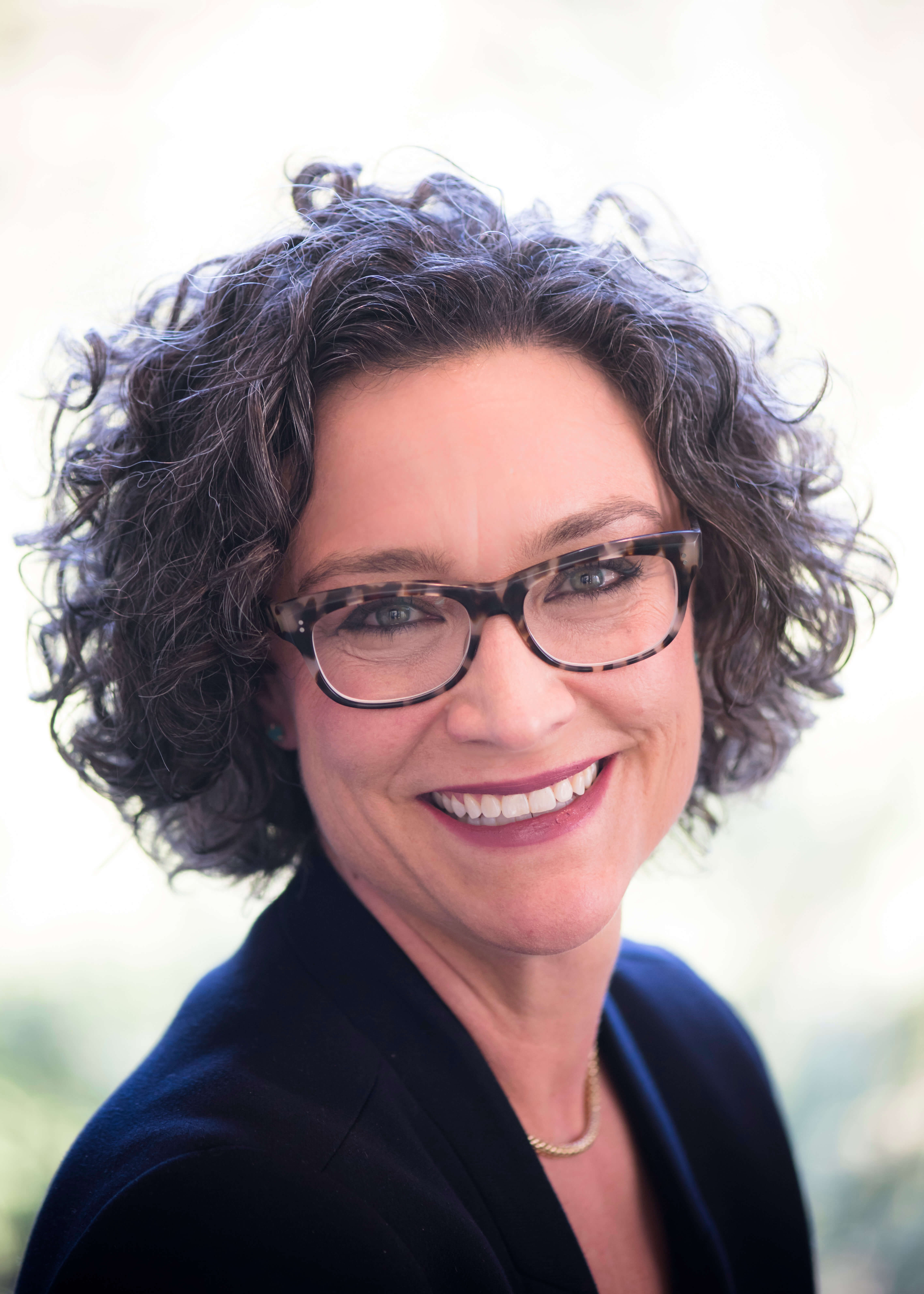 Respectfully yours,
Respectfully yours,
Elizabeth Cowell
Richard L. Press University Librarian
Presidential Chair
Communication and Collaboration - The new STEM Hub at S&E
For many children in underrepresented communities throughout the country, college is a distant dream, attainable only by relentless hard work both by the student and their parents. Once university is achieved, these students face even more boundaries to success,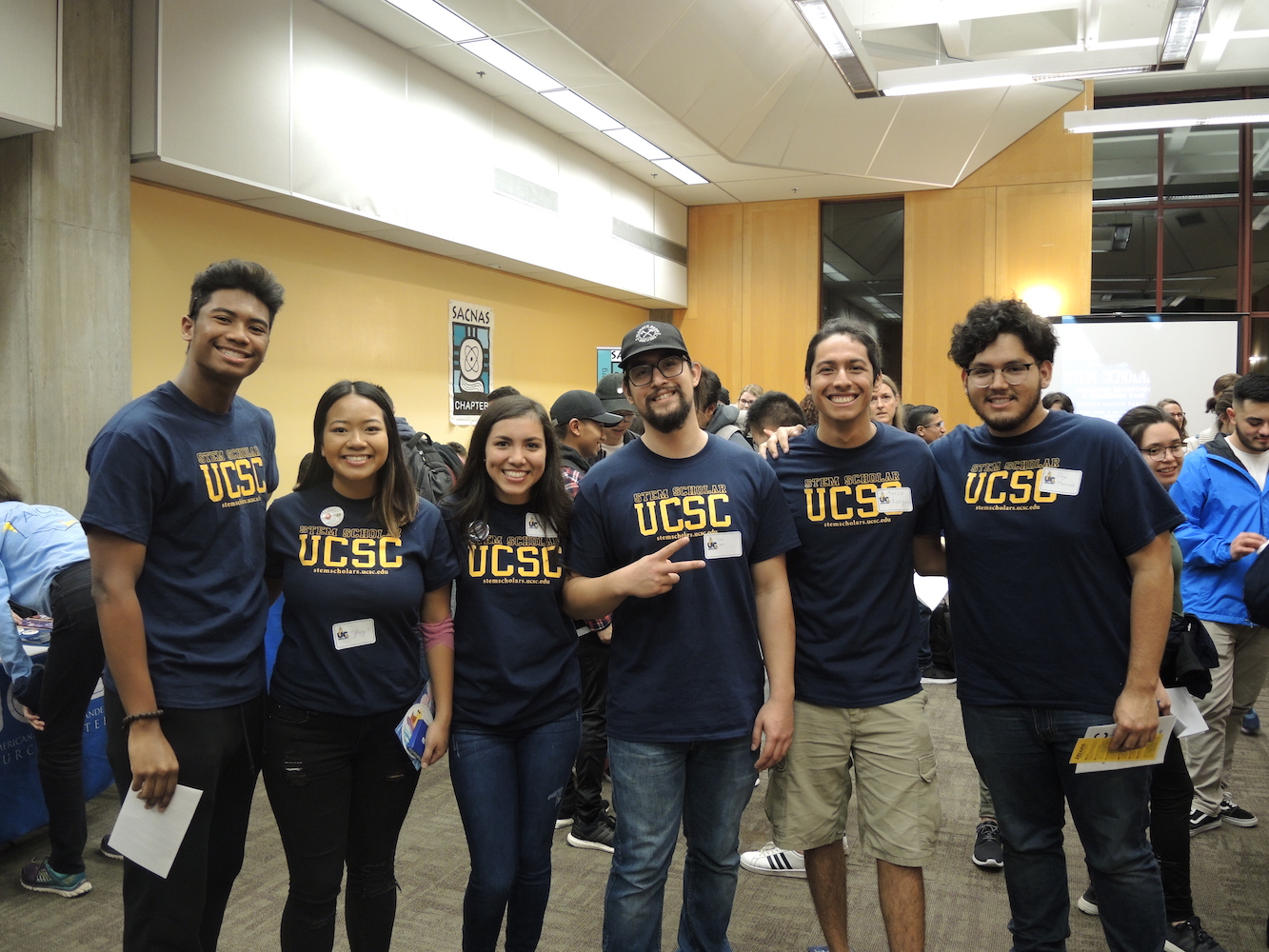 and often lack the skills and community needed to thrive in and graduate from college. Retention rates among these groups are dismally low, so even though on the surface UC Santa Cruz is a far more inclusive campus than when I attended twenty years ago, we have a way to go in terms of creating an infrastructure that can support these students in the ways they need.
and often lack the skills and community needed to thrive in and graduate from college. Retention rates among these groups are dismally low, so even though on the surface UC Santa Cruz is a far more inclusive campus than when I attended twenty years ago, we have a way to go in terms of creating an infrastructure that can support these students in the ways they need.
In 2015, UC Santa Cruz earned the Hispanic Serving Institution (HSI) designation, enabling the university to apply for federal grants to meet the needs of UCSC’s growing Latinx population. The HSI team defines its mission as such on its website:
At UCSC all of our students have earned admission to the university based on academic rigor, but not all students have the same resources and foundation to succeed at the university. Students’ communities, families, homes, economic backgrounds, and educational experiences vary widely -- leaving some students with greater challenges than others. To have a truly inclusive and excellent university we must acknowledge, understand, and design programs that account for and correct these disparities.
To find out more about the HSI team, its mission, and the new STEM Hub collaboration within the Science & Engineering Library, I met with Assistant Director René Moreno on a lovely autumn day on campus.
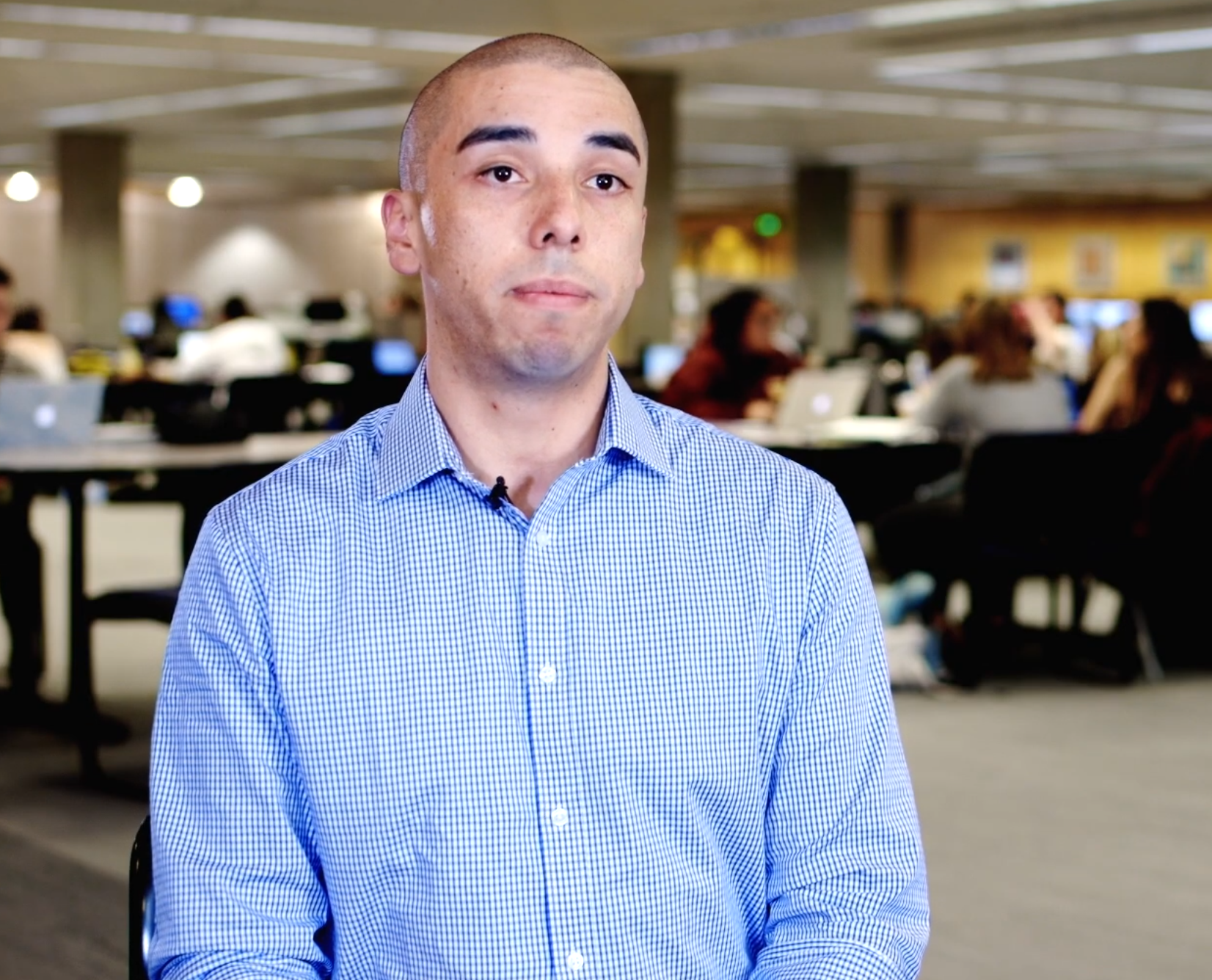 For René, the crucial component for supporting students from diverse backgrounds is community. Many of these students come in without any knowledge of the university structure, and often have an ingrained cultural resistance to asking for help. Because they feel that they have to do everything by themselves, too many get lost in the system, fall behind, and end up leaving early with a low GPA—all because they never felt like they fit in. To counteract this attrition rate, René says, it’s essential to give students a sense of belonging.
For René, the crucial component for supporting students from diverse backgrounds is community. Many of these students come in without any knowledge of the university structure, and often have an ingrained cultural resistance to asking for help. Because they feel that they have to do everything by themselves, too many get lost in the system, fall behind, and end up leaving early with a low GPA—all because they never felt like they fit in. To counteract this attrition rate, René says, it’s essential to give students a sense of belonging.
To this end, the Science & Engineering Library and the HSI Initiatives team have worked together to open a brand-new STEM Hub this fall, with the goal of supporting Latinx students in the STEM disciplines. As René points out, UCSC is known for its research in these areas, but many students arrive on campus unaware of this richness. They may not know what you can do with a STEM degree, or be able to explain to their parents and friends why taking an unpaid research internship is essential to their career. Many are hesitant to ask for help from professors and librarians, and end up struggling to negotiate the system by themselves. Their professors and advisors might even contribute to their alienation by unwittingly using discriminatory language or perpetrating microaggressions that make the students feel left out, which the HSI team combats by awareness and inclusion training for faculty.
With the support of a peer advisor, Latinx STEM students can better understand how to access the resources available to them on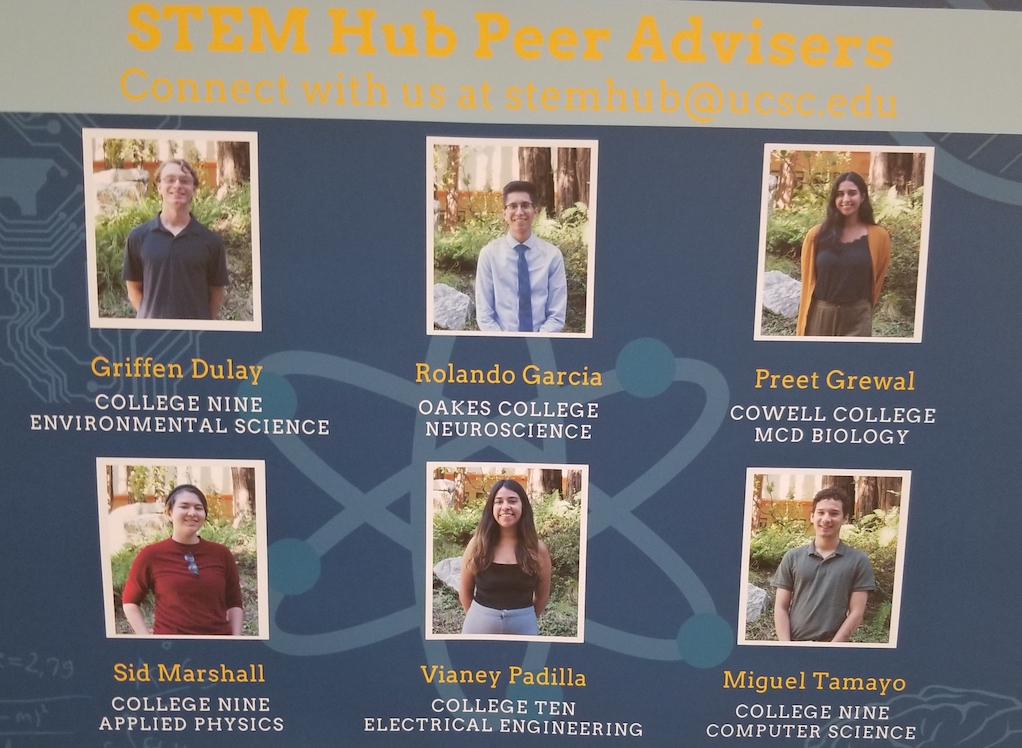 campus and in the libraries. These advisors have a wide understanding of everything happening on campus, and can help triage the students’ most immediate needs. There is also a study space with cubicles and a larger table that fits up to fourteen people at a time, providing much-needed physical space for these students to meet and work together. Once again, community and collaboration prove vital to improving success and retention rates.
campus and in the libraries. These advisors have a wide understanding of everything happening on campus, and can help triage the students’ most immediate needs. There is also a study space with cubicles and a larger table that fits up to fourteen people at a time, providing much-needed physical space for these students to meet and work together. Once again, community and collaboration prove vital to improving success and retention rates.
The STEM Hub also aims to support Educational Opportunity Program (EOP) transfer students in particular, helping them understand financial aid processes or to connect with the EOP and academic resource centers. These students are often older and/or have had previous careers, making it especially challenging for them to integrate into campus life. Events such as the STEM SEMILLA Welcome Fair, which brings together science-related clubs from all over campus, provide opportunities to meet and explore new connections for transfer students as soon as they start at UCSC.
René says that the library’s support in this endeavor has been crucial, and speaks to our commitment to supporting diversity and inclusion on the UCSC campus. The library’s mission is aligned with that of the HSI Initiatives: to help students succeed and, ultimately, to become leaders in their field. Many of these students are coming from strong community and family backgrounds and need an equally strong community at college to lift them up and help them thrive. The library, René says, has been a key partner in building this much-needed community and in helping students from all backgrounds succeed.
Inclusive and Effective Classrooms Benefit Students
In 2017, I [Zoe Quinton] went to visit the Active Learning Classroom in the Science & Engineering Library for a piece I wrote for this newsletter. As a former humanities student, I was amazed not only by the facilities that were available, but also by the pedagogical ethos that underlie everything in this state-of-the-art classroom. It is hands-on, crowd-based learning at its best, encouraging both students and professors to think outside the box.
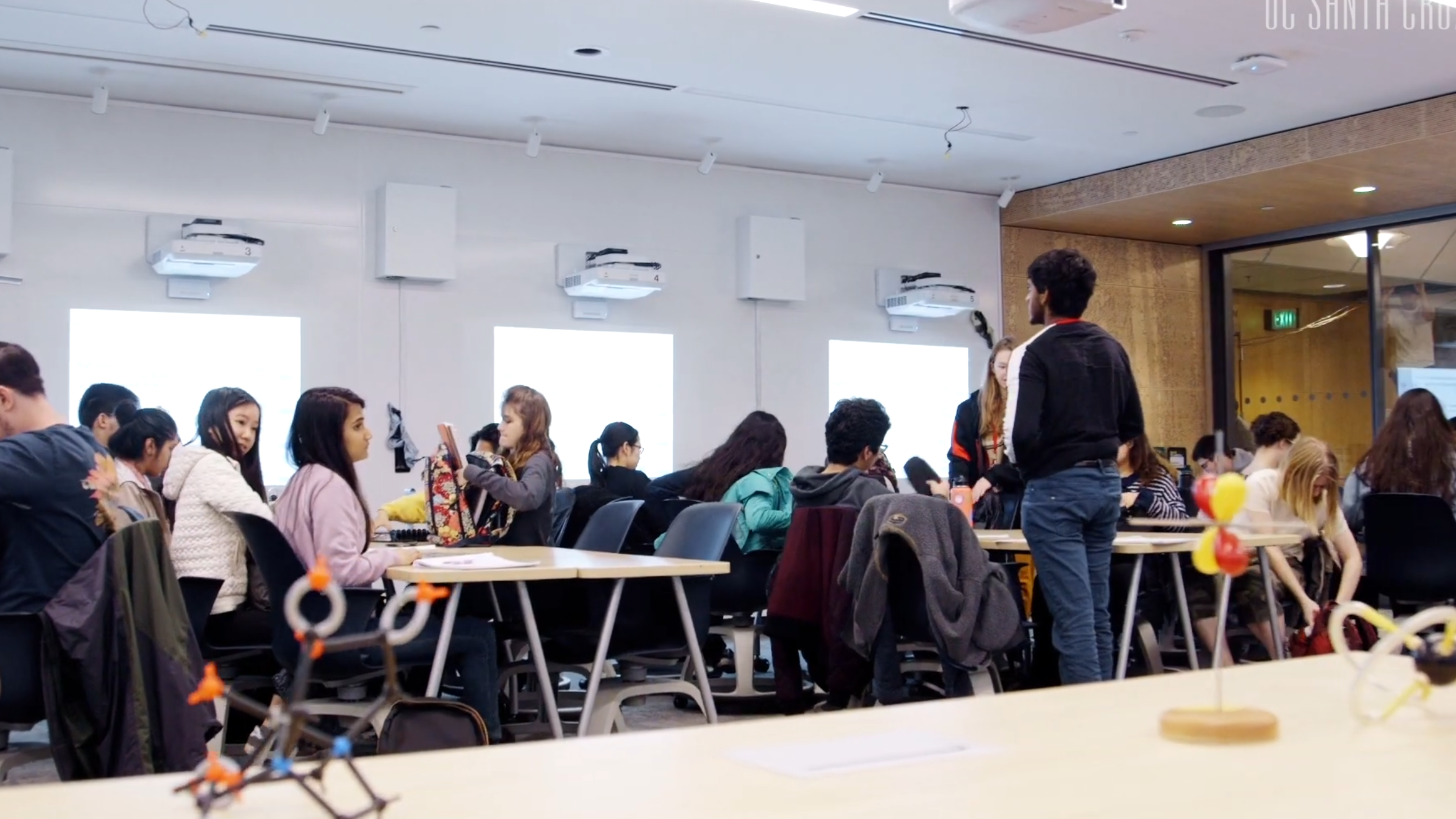 Instead of having a professor stand at a podium and lecture to a large room with rows of students, the ALC splits the students up into smaller tables, which are easily configurable into whatever format is most conducive to the task at hand. The walls are lined with whiteboards, and each station has a separate projector, which can either all be synced directly to the main presentation or used for small group work.
Instead of having a professor stand at a podium and lecture to a large room with rows of students, the ALC splits the students up into smaller tables, which are easily configurable into whatever format is most conducive to the task at hand. The walls are lined with whiteboards, and each station has a separate projector, which can either all be synced directly to the main presentation or used for small group work.
When I visited it, the ALC had just opened, so I was unable to truly witness it in action. I was glad to talk further with Professor Susan Strome of the Molecular, Cell, and Developmental Biology Department about her experience teaching there. Her focus has been on putting the techniques she’s developed in the ALC to use in larger classrooms—her intro to genetics class, for example, has over two hundred students in it, which would be impossible to fit into the ALC. However, she says, you can’t disadvantage the bigger classes by not allowing them to have the same learning experience as the smaller ones. So how can you scale the best practices developed in the ALC to work for large lecture halls?
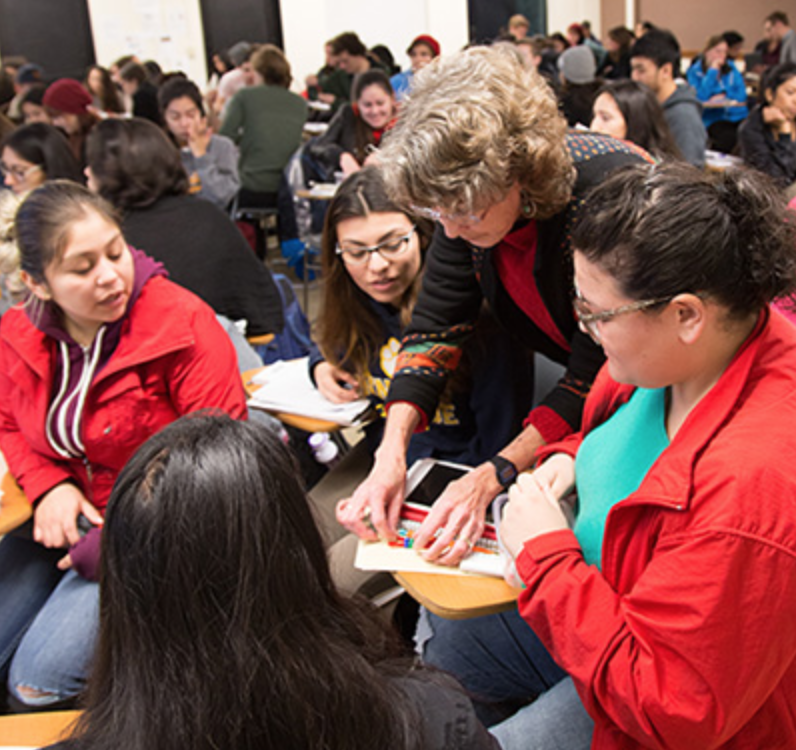 To solve this issue, Strome says that she and a few other professors have used the ALC as a “sandbox” of sorts to develop ideas to implement in the larger classroom. For example, she spends forty-five minutes to an hour lecturing, then opens the rest of the class up to discussion. And, instead of filling up the lecture hall, her students leave a few empty rows at regular intervals, allowing herself and the TAs to circulate and interact with the students during the discussion period. This simulates the more intimate, collaborative environment of the ALC, allowing students to ask questions and debate ideas directly.
To solve this issue, Strome says that she and a few other professors have used the ALC as a “sandbox” of sorts to develop ideas to implement in the larger classroom. For example, she spends forty-five minutes to an hour lecturing, then opens the rest of the class up to discussion. And, instead of filling up the lecture hall, her students leave a few empty rows at regular intervals, allowing herself and the TAs to circulate and interact with the students during the discussion period. This simulates the more intimate, collaborative environment of the ALC, allowing students to ask questions and debate ideas directly.
The key to all this, Strome told me, is that an active learning environment—no matter what the size—increases the students’ sense of belonging. Robin Dunkin, a biology professor at UC Santa Cruz, both studies and employs evidence-based teaching methods to create more rigorous, inclusive, and effective classrooms. In her analysis, you can scale small active learning techniques to big classrooms effectively without diminishing the students’ sense of belonging. By giving future scientists a sense of what science practices are through hands-on experience, you let them see that they do belong at UCSC, or in a STEM discipline, or even just in this class.
As with the STEM Hub, the sense of belonging cultivated by collaboration with other students and faculty members is crucial to student success. This lesson is becoming increasingly important as the student body becomes more and more diverse, so I hope that work like Professor Strome’s in the ALC will continue to inform and inspire teaching standards across all disciplines and class sizes.
Our donor highlight features Professor Emerita Margaret Brose
From the 1980s through the early 2000s, Margaret Brose and Hayden White were a UC Santa Cruz power couple. She taught in the Department of Literature, and he was the first full professor and chair of the “Board of Studies in the History of Consciousness,” as it was called then. Previously, the HisCon graduate degree had been overseen by multiple other departments, with no full-time faculty appointed to the program. When White joined the faculty in 1978, it was to oversee the graduate program as a cohesive whole for the first time. Soon after that, the HisCon department became world-renowned both for its truly interdisciplinary nature and for the high caliber of its professors, including James Clifford, Donna Haraway, Angela Davis, Teresa de Lauretis, and Victor Burgen.
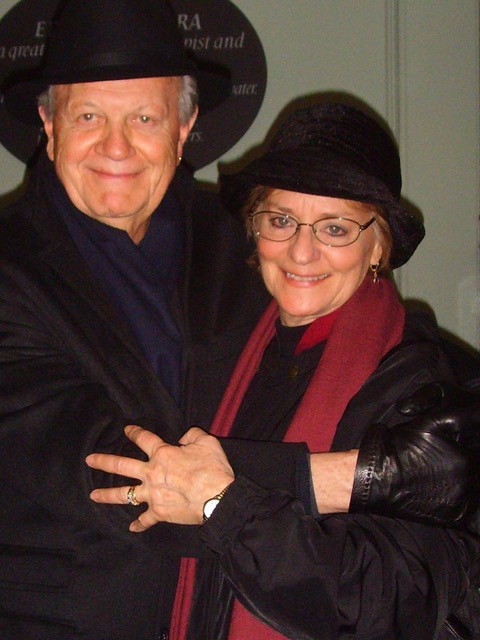 The couple got their start, however, as young medievalist doctoral candidates studying in Rome, more than a decade apart (Hayden in the mid 1950s and Margaret in the late 1960s). Although they both moved on to teach and research other subjects, Italy, Medieval Studies, and the Renaissance remained lifelong themes in their academic efforts. Over the years, they have donated more than 140 rare books to the University Library’s Special Collections & Archives (“The Brose-White Rare Book Collection”). The majority of these texts are from the 16th Century, written in either in Latin, Italian, or French; and deal with philosophy and literature. When I spoke to Margaret by phone, she told me that White started picking these old books up from the vendors along the banks of the Tiber in Rome when he was a graduate student there, and the couple continued the habit during the many years they lived in that city. While most of the books were not purchased for their economic value, some of them turned out to be quite valuable, and the “Brose-White Rare Book Collection” has been a wonderful contribution to our Special Collections & Archives here at UC Santa Cruz.
The couple got their start, however, as young medievalist doctoral candidates studying in Rome, more than a decade apart (Hayden in the mid 1950s and Margaret in the late 1960s). Although they both moved on to teach and research other subjects, Italy, Medieval Studies, and the Renaissance remained lifelong themes in their academic efforts. Over the years, they have donated more than 140 rare books to the University Library’s Special Collections & Archives (“The Brose-White Rare Book Collection”). The majority of these texts are from the 16th Century, written in either in Latin, Italian, or French; and deal with philosophy and literature. When I spoke to Margaret by phone, she told me that White started picking these old books up from the vendors along the banks of the Tiber in Rome when he was a graduate student there, and the couple continued the habit during the many years they lived in that city. While most of the books were not purchased for their economic value, some of them turned out to be quite valuable, and the “Brose-White Rare Book Collection” has been a wonderful contribution to our Special Collections & Archives here at UC Santa Cruz.
Brose’s classes on Dante—her most popular courses during her time at Santa Cruz—reflected these medieval Italian scholarly roots. She alternated teaching a smaller Dante class in which students read the Inferno in the original Italian, with a much larger lecture class using a translated version of the entire Divine Comedy. In both classes, Brose made full use of the books in Special Collections & Archives to supplement her teaching. As she described it, she would ask Beth Remak-Honnef, former head of Special Collections & Archives, to pull out a selection of materials from the 14th to the 16th Centuries, to give her students a sense of what a medieval manuscript looks like. Brose also had Beth assemble a selection of the most famous illustrations of the Divine Comedy, in order to introduce her students to the famous 700-year tradition of illustrating Dante. Even in her larger classes, Brose would encourage her TAs to take their sections to to McHenry Library to see the manuscripts for themselves. Brose also taught many other classes, including Italian Novel and Film, Italian Jewish Writing, European Romanticism, and the Medieval Love Lyric. She continues to teach Dante courses through UC Santa Cruz’s OLLI (Osher Lifelong Learning Institute).
Today, the legacy of both Brose and White’s time on campus continues to be felt in multiple ways. Beyond their Rare Book Collection, after White’s death in March of 2018, Brose donated the entirety of White’s papers and his library of his annotated books to Special Collections & Archives . Brose says that the two graduate students who worked on archiving the Hayden White Papers [CART Fellows] are both in the HisCon department and were deeply influenced by White’s thinking; thus, they were able to cull through and to organize the materials McHenry acquired with his true spirit in mind.
There is currently an exhibit featuring “The Hayden White Papers” on display through March 2020 in McHenry’s Third Floor Gallery (more information can be found here). Also, in early November, The Humanities Institute at UC Santa Cruz hosted a two-day international conference to continue White’s academic legacy, entitled “Against Orthodoxies: Working with Hayden White.” (Information on the conference is here.)
As for Brose herself, she says that her family history with McHenry library goes back many years. When Frank Zwart, the campus architect of UC Santa Cruz, worked on the renovation of McHenry Library, he asked Morris Brose (Margaret’s father and a well-known sculptor) to donate a piece of bronze sculpture. That piece, “Sentinel,” stands in front of the café area to this day, and is a seminal piece of the campus architecture.
It is not often that I get to talk with someone as accomplished and fundamental to the history of UC Santa Cruz as Margaret Brose, and I thoroughly enjoyed our conversation. The Brose/White donations will continue to be an integral part of Special Collections & Archives and the spirit of UC Santa Cruz for a long time to come.
News from Special Collections and Archives
New Exhibit: “Archival Research as Penance”: The Papers and Library of Hayden V. White
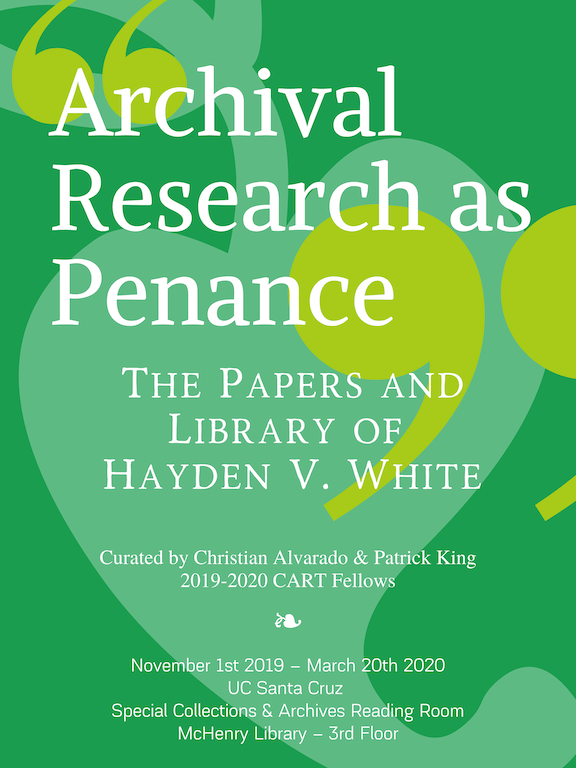 “Archival Research as Penance”: The Papers and Library of Hayden V. White is the University Library’s newest exhibit featuring archival materials made available by the Elisabeth Remak-Honnef Center for Archival Research and Training (CART). Curated by History of Consciousness graduate students and 2019-2020 CART Fellows Christian Alvarado and Patrick King, this exhibit honors the work of the late Hayden White, the influential historian and professor emeritus in UC Santa Cruz’s History of Consciousness Department.
“Archival Research as Penance”: The Papers and Library of Hayden V. White is the University Library’s newest exhibit featuring archival materials made available by the Elisabeth Remak-Honnef Center for Archival Research and Training (CART). Curated by History of Consciousness graduate students and 2019-2020 CART Fellows Christian Alvarado and Patrick King, this exhibit honors the work of the late Hayden White, the influential historian and professor emeritus in UC Santa Cruz’s History of Consciousness Department.
The exhibit presents the various sites of Hayden White’s intellectual work, teaching, and activism through White’s paper and digital files, which are newly available for research in the Special Collections & Archives Reading Room. The title “Archival Research as Penance” echoes a handwritten note scribbled on a research folder White compiled on Giambattista Vico: it indicates the unorthodox insights and rhetorical flair he brought to the practice of criticism.
In the exhibit, White’s dedication, thoroughness, and proclivity for exploration are displayed across his writings, research files, teaching materials, and correspondence. The documents related to his foundational role in building the pathbreaking interdisciplinary History of Consciousness program at UC Santa Cruz stand as a testament to his belief in crossing received boundaries and nurturing scholarly creativity. The drafts and translations of his renowned 1973 work, Metahistory, point to the enduring power of White’s challenge to prevailing ideas of historical interpretation. Notable too are the files related to White’s involvement as complainant in the 1975 White v. Davis court case brought against the Los Angeles Police Department, a landmark legal ruling in favor of the civil rights of students in the United States, which he regarded as one of his proudest accomplishments. In mapping the times and spaces where White elaborated his ideas, “Archival Research as Penance”: The Papers and Library of Hayden V. White invites others to think with him.
The exhibit is on display in the Special Collections & Archives Reading Room, McHenry Library Third Floor, through March 20, 2020. Current hours of Special Collections & Archives can be consulted on the library’s website.
Special Collections & Archives is grateful to Margaret Brose, whose generous donation of Hayden White’s archives to the University Library has made this exhibit possible. Thanks also go to The Humanities Institute for its support of fellowships in the Elisabeth Remak-Honnef Center for Archival Research and Training.
Closing December 1st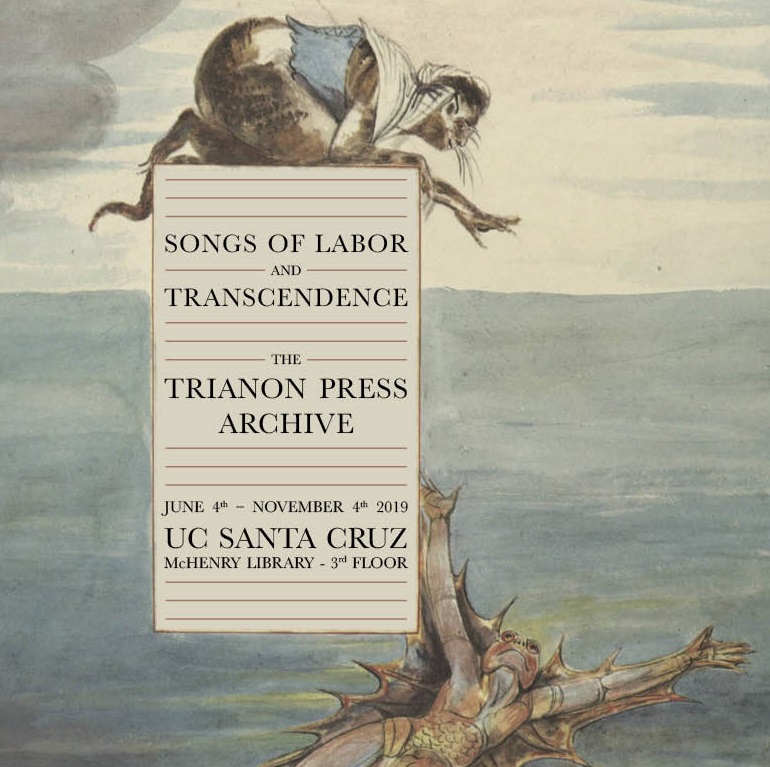 Songs of Labor & Transcendence: The Trianon Press Archive, curated by 2018-2019 Center for Archival Research and Training (CART) Fellows Morgan Gates, Jessica Calvanico, Hannah Newburn, and Nicholas Whittington, is on view in McHenry Library’s Third Floor Gallery through December 1st. After it closes, you can still visit the Fellows’ digital exhibit on the Trianon Press.
Songs of Labor & Transcendence: The Trianon Press Archive, curated by 2018-2019 Center for Archival Research and Training (CART) Fellows Morgan Gates, Jessica Calvanico, Hannah Newburn, and Nicholas Whittington, is on view in McHenry Library’s Third Floor Gallery through December 1st. After it closes, you can still visit the Fellows’ digital exhibit on the Trianon Press.
Closing December 23rd Put Your Gold Money Where Your Love Is, Baby: Counterculture, Capitalism, and the Grateful Dead is on view in Brittingham Dead Central on McHenry Library’s second floor through December 23rd. In addition to co-curating this exhibit, UCSC graduate student and 2017-2018 CART Fellow Gabriel Salomon Mindel also created a digital companion to the exhibit called A Touch of Greymarket: Capitalism at the Grateful Dead Show.
Put Your Gold Money Where Your Love Is, Baby: Counterculture, Capitalism, and the Grateful Dead is on view in Brittingham Dead Central on McHenry Library’s second floor through December 23rd. In addition to co-curating this exhibit, UCSC graduate student and 2017-2018 CART Fellow Gabriel Salomon Mindel also created a digital companion to the exhibit called A Touch of Greymarket: Capitalism at the Grateful Dead Show.
Coming in Spring 2020
Seeds of Something Different: Documenting UC Santa Cruz in Image and Narrative Opening in March 2020, in McHenry Library’s Third Floor Gallery
Opening in March 2020, in McHenry Library’s Third Floor Gallery
This exhibit will celebrate the publication of Seeds of Something Different: An Oral History of the University of California, Santa Cruz, which weaves together first-person accounts of the campus’s evolution, from the origins of an audacious dream through the sea changes of five decades. More than two hundred narrators and a trove of archival images from Special Collections contribute to this dynamic, nuanced account.
When We Paint Our Masterpiece: The Art of the Grateful Dead Community
Opening in February 2020, in Brittingham Dead Central on McHenry Library’s second floor
Drawing on the Grateful Dead’s archive, this exhibit will explore how members of this iconic band and their fans inspired one another in creating an image-rich worldwide art practice that, like the band’s music, scrambled perceived standards and norms.
Collectors' Club Selection Day
 On July 9th, our Collectors Club members met in the Special Collections & Archives Reading Room to participate in the second annual Collectors Club Selection Day. Over the course of the afternoon, members were introduced to prospective acquisitions for possible purchase by the Club. Pieces ranged from the recently published, hand-set and hand-illustrated, Travels of Sir John Mandeville Beyond the Holy Land by local fine printers, Foolscap Press; an artist’s ruminations on memory loss, Memory Lane; and a 1676 printing of In Praise of Folly by Erasmus. After poring over the prospective purchases and beginning a lively dialogue about how the individual works would augment the existing collection and be used in teaching, we adjourned to the Administrative Suite to further deliberate and make the final acquisition decisions over tea and cake. Five pieces in all were presented to the Club for their consideration, and we are thrilled to report that we were able to acquire all five works. The Collectors Club sponsored the purchase of three pieces and the remaining two works were purchased for Special Collections by members Kathy Rose and David Kirk. Special Collections & Archives is grateful for Collectors Club members' attention and support of the Library's work to build a strong, teaching-focused collection. Please contact Joop Rubens at 831.459.5870 if you are interested in learning more about the Collectors Club.
On July 9th, our Collectors Club members met in the Special Collections & Archives Reading Room to participate in the second annual Collectors Club Selection Day. Over the course of the afternoon, members were introduced to prospective acquisitions for possible purchase by the Club. Pieces ranged from the recently published, hand-set and hand-illustrated, Travels of Sir John Mandeville Beyond the Holy Land by local fine printers, Foolscap Press; an artist’s ruminations on memory loss, Memory Lane; and a 1676 printing of In Praise of Folly by Erasmus. After poring over the prospective purchases and beginning a lively dialogue about how the individual works would augment the existing collection and be used in teaching, we adjourned to the Administrative Suite to further deliberate and make the final acquisition decisions over tea and cake. Five pieces in all were presented to the Club for their consideration, and we are thrilled to report that we were able to acquire all five works. The Collectors Club sponsored the purchase of three pieces and the remaining two works were purchased for Special Collections by members Kathy Rose and David Kirk. Special Collections & Archives is grateful for Collectors Club members' attention and support of the Library's work to build a strong, teaching-focused collection. Please contact Joop Rubens at 831.459.5870 if you are interested in learning more about the Collectors Club.
Science & Engineering Library Renovation Update
As the new school year got underway, progress on the third floor renovation to the Science & Engineering Library really kicked into high gear. After months of careful planning and documentation, and after securing myriad stakeholder approvals—from the campus all the way up to the State Architect—we were ready to put our plan into motion.
Our biggest engineering challenge was replacing two massive twenty-eight-year-old air handling units on the roof. The first 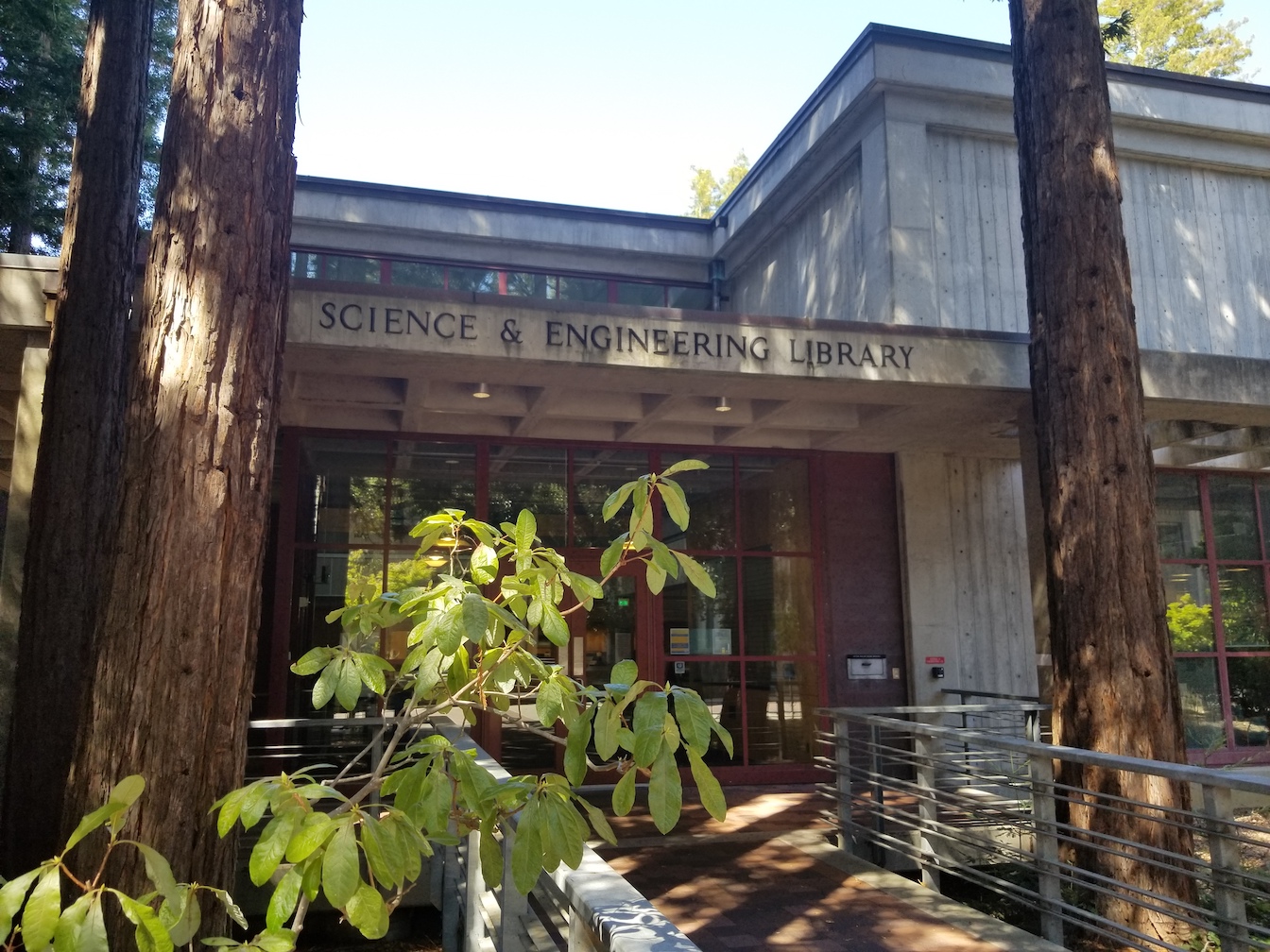 replacement unit was crane-lifted into place just last week. The second one is scheduled to go up just after finals. When they are commissioned, these new, quieter, more powerful, and more energy-efficient units will serve library visitors well for years to come.
replacement unit was crane-lifted into place just last week. The second one is scheduled to go up just after finals. When they are commissioned, these new, quieter, more powerful, and more energy-efficient units will serve library visitors well for years to come.
We had a couple of noisy days in October as we drilled through the floor to add plumbing to support two new gender-neutral bathrooms, but we met our goal to get the noisiest work done with before midterms. We anticipate no noise distractions for the rest of the quarter, but just in case we are wrong about that, we have earplugs available for the asking at the service desk.
For the next month or so we will be coordinating with various trades and inspectors to make sure that everything is ready on time for each of them to make their contribution to finishing the project. We are confident that we are on track to open the renovated third floor on time in January. We look forward to welcoming our students to a beautiful new space with 440 study seats, convenient access to AC and USB power, over 1,000 square feet of new markerboard surface, and four new group study rooms.
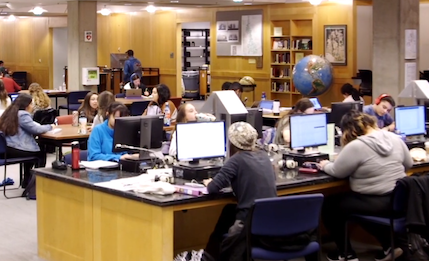 Watch our latest video:
Watch our latest video:
Science and Engineering Library renovations focus on student needs
An Easy Way to Support the UC Santa Cruz Library
If you're looking for a tax-wise strategy to make gifts to the Library, consider making an IRA Charitable Rollover. If you're age 70 ½ or older, you can use your Individual Retirement Account to support the UC Santa Cruz University Library. Any amount you transfer will count against your required minimum distribution, meaning it won't be counted as taxable income this year, thus reducing your tax burden. Making a gift through an IRA rollover helps you make a significant impact with minimal effort.
If you'd like to learn more about Charitable IRA rollovers, or how you can maximize your giving through non-cash gifts like your retirement accounts, real property, or investments please contact the Office of Planned Giving at gift.planning@ucsc.edu or (831) 459-1045.
Have you included the University Library in your estate plan? Please Let Us Know if the library is part of your will or trust so we can ensure that your future donation is honored, and your legacy lives on, in the precise manner you wish. All you have to do is tell us!
Credits:
Contributors: Elizabeth Cowell, Zoe Quinton, Alix Norton, Jessica Pigza, Greg Careaga and Teresa Mora
Production: Linda Hunt
Copyediting: Greg Careaga
Photography: Linda Hunt, Alix Norton, UCSC Photo Collection and Carolyn Lagattuta
Video Production: Nick Gonzales


 Santa Cruz, CA
Santa Cruz, CA



